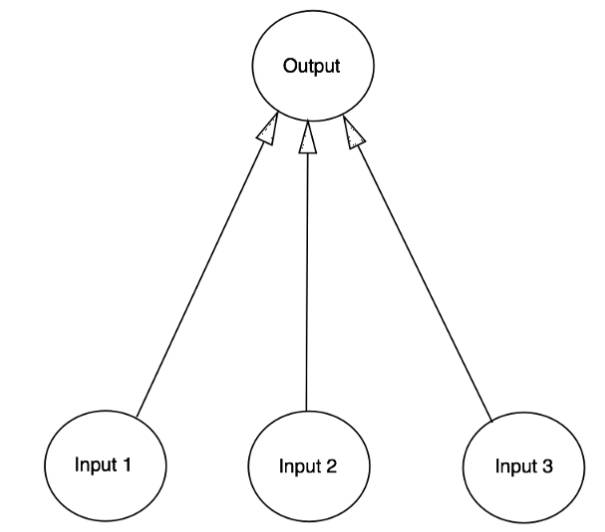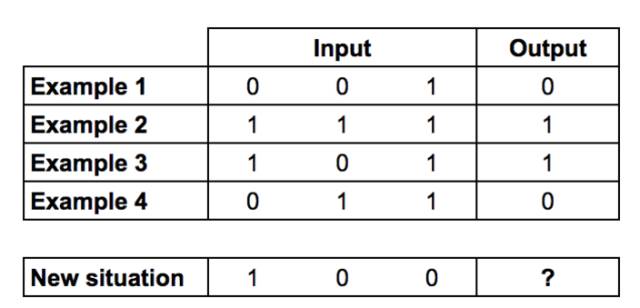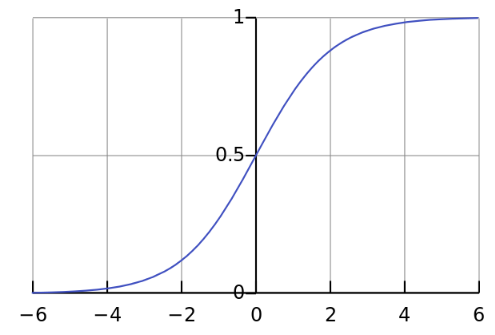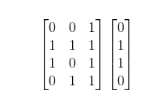


Python培训
400-996-5531
本文作者手把手解释了搭建神经网络的过程,看完你也可以搭建一个属于自己的神经网络。这里会提供一个加长版、但是也更整洁的源代码。
from numpy import exp, array, random, dot
training_set_inputs = array([[0, 0, 1], [1, 1, 1], [1, 0, 1], [0, 1, 1]])
training_set_outputs = array([[0, 1, 1, 0]]).T
random.seed(1)
synaptic_weights = 2 * random.random((3, 1)) - 1
for iteration in xrange(10000):
output = 1 / (1 + exp(-(dot(training_set_inputs, synaptic_weights))))
synaptic_weights += dot(training_set_inputs.T, (training_set_outputs - output) * output * (1 - output))
print 1 / (1 + exp(-(dot(array([1, 0, 0]), synaptic_weights))))
▍什么是神经网络?
人脑总共有超过千亿个神经元细胞,通过神经突触相互连接。如果一个神经元被足够强的输入所激活,那么它也会激活其他神经元,这个过程就叫“思考”。
我们可以在计算机上创建神经网络,来对这个过程进行建模,且并不需要模拟分子级的生物复杂性,只要观其大略即可。为了简化起见,我们只模拟一个神经元,含有三个输入和一个输出。

我们将训练这个神经元来解决下面这个问题,前四个样本叫作“训练集”,你能求解出模式吗??处应该是0还是1呢?

或许已经发现了,输出总是与第一列的输入相等,所以?应该是1。
▍训练过程
问题虽然很简单,但是如何教会神经元来正确的回答这个问题呢?我们要给每个输入赋予一个权重,权重可能为正也可能为负。权重的绝对值,代表了输入对输出的决定权。在开始之前,我们先把权重设为随机数,再开始训练过程:
从训练集样本读取输入,根据权重进行调整,再代入某个特殊的方程计算神经元的输出。
计算误差,也就是神经元的实际输出和训练样本的期望输出之差。
根据误差的方向,微调权重。
重复10000次。

最终神经元的权重会达到训练集的最优值。如果我们让神经元去思考一个新的形势,遵循相同过程,应该会得到一个不错的预测。
▍计算神经元输出的方程
你可能会好奇,计算神经元输出的人“特殊方程”是什么?首先我们取神经元输入的加权总和:

接下来我们进行正规化,将结果限制在0和1之间。这里用到一个很方便的函数,叫Sigmoid函数:

如果绘出图像,Sigmoid函数是S形的曲线:


将第一个公式代入第二个,即得最终的神经元输出方程:

▍调整权重的方程
在训练进程中,我们需要调整权重,但是具体如何调整呢?就要用到“误差加权导数”方程:

为什么是这个方程?首先我们希望调整量与误差量成正比,然后再乘以输入(0-1)。如果输入为0,那么权重就不会被调整。最后乘以Sigmoid曲线的梯度,为便于理解,请考虑:
我们使用Sigmoid曲线计算神经元输出。
如果输出绝对值很大,这就表示该神经元是很确定的(有正反两种可能)。
Sigmoid曲线在绝对值较大处的梯度较小。
如果神经元确信当前权重值是正确的,那么就不需要太大调整。乘以Sigmoid曲线的梯度可以实现。
Sigmoid曲线的梯度可由导数获得:

代入公式可得最终的权重调整方程:

实际上也有其他让神经元学习更快的方程,这里主要是取其相对简单的优势。
▍构建Python代码
尽管我们不直接用神经网络库,但还是要从Python数学库Numpy中导入4种方法:
exp: 自然对常数
array: 创建矩阵
dot:矩阵乘法
random: 随机数
比如我们用array()方法代表训练集:
training_set_inputs = array([[0, 0, 1], [1, 1, 1], [1, 0, 1], [0, 1, 1]])
training_set_outputs = array([[0, 1, 1, 0]]).T
.T函数就是矩阵转置。我想现在可以来看看美化版的源代码了:

最后我还会提出自己的终极思考。源代码中已经添加了注释逐行解释。注意每次迭代我们都一并处理了整个训练集,以下为完整的Python示例:
from numpy import exp, array, random, dot
class NeuralNetwork():
def __init__(self):
# Seed the random number generator, so it generates the same numbers
# every time the program runs.
random.seed(1)
# We model a single neuron, with 3 input connections and 1 output connection.
# We assign random weights to a 3 x 1 matrix, with values in the range -1 to 1
# and mean 0.
self.synaptic_weights = 2 * random.random((3, 1)) - 1
# The Sigmoid function, which describes an S shaped curve.
# We pass the weighted sum of the inputs through this function to
# normalise them between 0 and 1.
def __sigmoid(self, x):
return 1 / (1 + exp(-x))
# The derivative of the Sigmoid function.
# This is the gradient of the Sigmoid curve.
# It indicates how confident we are about the existing weight.
def __sigmoid_derivative(self, x):
return x * (1 - x)
# We train the neural network through a process of trial and error.
# Adjusting the synaptic weights each time.
def train(self, training_set_inputs, training_set_outputs, umber_of_training_iterations):
for iteration in xrange(number_of_training_iterations):
# Pass the training set through our neural network (a single neuron).
output = self.think(training_set_inputs)
# Calculate the error (The difference between the desired output
# and the predicted output).
error = training_set_outputs - output
# Multiply the error by the input and again by the gradient of the Sigmoid curve.
# This means less confident weights are adjusted more.
# This means inputs, which are zero, do not cause changes to the weights.
adjustment = dot(training_set_inputs.T, error * self.__sigmoid_derivative(output))
# Adjust the weights.
self.synaptic_weights += adjustment
# The neural network thinks.
def think(self, inputs):
# Pass inputs through our neural network (our single neuron).
return self.__sigmoid(dot(inputs, self.synaptic_weights))
if __name__ == "__main__":
#Intialise a single neuron neural network.
neural_network = NeuralNetwork()
print "Random starting synaptic weights: "
print neural_network.synaptic_weights
# The training set. We have 4 examples, each consisting of 3 input values
# and 1 output value.
training_set_inputs = array([[0, 0, 1], [1, 1, 1], [1, 0, 1], [0, 1, 1]])
training_set_outputs = array([[0, 1, 1, 0]]).T
# Train the neural network using a training set.
# Do it 10,000 times and make small adjustments each time.
neural_network.train(training_set_inputs, training_set_outputs, 10000)
print "New synaptic weights after training: "
print neural_network.synaptic_weights
# Test the neural network with a new situation.
print "Considering new situation [1, 0, 0] -> ?: "
print neural_network.think(array([1, 0, 0]))
▍结果
Random starting synaptic weights:
[[-0.16595599]
[ 0.44064899]
[-0.99977125]]
New synaptic weights after training:
[[ 9.67299303]
[-0.2078435 ]
[-4.62963669]]
Considering new situation [1, 0, 0] -> ?:
[ 0.99993704]
我们做到了!我们使用Python构建了一个简单的神经网络!
首先,神经网络分配自身随机权重,然后使用训练集训练自己。然后考虑一个新的情况[1,0,0]并预测0.99993704。正确的答案是1.所以非常接近!
传统的电脑程式通常无法学习。神经网络令人惊奇的是可以自学习,适应和应对新情况。
github:https://github.com/miloharper/simple-neural-network
填写下面表单即可预约申请免费试听! 怕学不会?助教全程陪读,随时解惑!担心就业?一地学习,可全国推荐就业!
Copyright © Tedu.cn All Rights Reserved 京ICP备08000853号-56  京公网安备 11010802029508号 达内时代科技集团有限公司 版权所有
京公网安备 11010802029508号 达内时代科技集团有限公司 版权所有